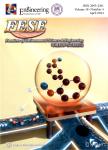Elimination of antibiotic resistance genes and control of horizontal transfer risk by UV-based treatment of drinking water: A mini review
作者机构:Department of Environmental and Occupational Health School of Public Health Texas A&M University College Station TX 77843 USA Institute of Urban Environment Chinese Academy of Sciences Xiamen 361021 China Central Texas Veterans Health Care System Temple TX 76504 USA College of Medicine Texas A&M Health Science Center Bryan TX 77807 USA Environmental Engineering and Science Program Department of Chemical and Environmental Engineering (DChEE) 705 Engineering Research Center University of Cincinnati Cincinnati OH 45221 USA
出 版 物:《Frontiers of Environmental Science & Engineering》 (环境科学与工程前沿(英文))
年 卷 期:2019年第13卷第3期
页 面:3-11页
核心收录:
学科分类:12[管理学] 0830[工学-环境科学与工程(可授工学、理学、农学学位)] 1201[管理学-管理科学与工程(可授管理学、工学学位)] 08[工学]
基 金:the Program of Environmental and Sustainability,SPH,TAMU for the support supported by the Central Texas Veterans Health Care System(Temple,Texas)
主 题:Antibiotic resistance bacteria Advanced oxidation processes Disinfection Reactive chlorine species Sulfate radicals Reactive oxygen species
摘 要:Antibiotic-resistant bacteria (ARB) and antibiotic resistance genes (ARGs) have been recognized as one of the biggest public health issues of the 21 st century. Both ARB and ARGs have been determined in water after treatment with conventional disinfectants. Ultraviolet (UV) technology has been seen growth in application to disinfect the water. However, UV method alone is not adequate to degrade ARGs in water. Researchers are investigating the combination of UV with other oxidants (chlorine, hydrogen peroxide (H2O2), peroxymonosulfate (PMS), and photocatalysts) to harness the high reactivity of produced reactive species (C1-, C1O -, Cl2-,-OH, and SO4-_) in such processes with constituents of cell (e.g., deoxyribonucleic acid (DNA) and its components) in order to increase the degradation efficiency of ARGs. This paper briefly reviews the current status of different UV-based treatments (UV/chlorination, UV/H2O2, UV/PMS, and UV-photocatalysis) to degrade ARGs and to control horizontal gene transfer (HGT) in water. The review also provides discussion on the mechanism of degradation of ARGs and application of q-PCR and gel electrophoresis to obtain insights of the fate of ARGs during UV-based treatment processes.



